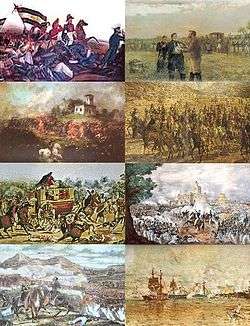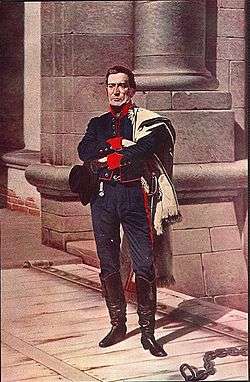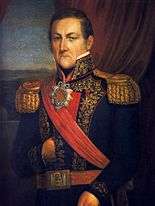Argentine Civil Wars
| Argentine Civil Wars | |||||||
|---|---|---|---|---|---|---|---|
 From top left: Battle of Arroyo Grande, execution of Manuel Dorrego, Battle of Pavón, death of Juan Lavalle, murder of Facundo Quiroga, Battle of Caseros, Battle of Famaillá, Battle of Vuelta de Obligado. | |||||||
| |||||||
| Belligerents | |||||||
|
|
| ||||||
| Commanders and leaders | |||||||
|
|
| ||||||
The Argentine Civil Wars were a series of internecine wars that took place in Argentina from 1814 to 1880. These conflicts were separate from the Argentine War of Independence (1810–1820), though they first arose during this period.
The main antagonists were, on a geographical level, Buenos Aires Province and the other provinces of modern Argentina, and on a political level, between the Federal Party and the Unitarian Party. The central cause of the conflict was the excessive centralism advanced by Buenos Aires leaders and, for a long period, the monopoly on the use of the Port of Buenos Aires as the sole means for international commerce. Other participants at specific times included Uruguay, and the British and French empires, notably in the French blockade of the Río de la Plata of 1838 and in the Anglo-French blockade of the Río de la Plata that ended in 1850.
Overview
Early conflicts against centralized rule

Regionalism had long marked the relationship among the numerous provinces of what today is Argentina, and the wars of independence did not result in national unity. The establishment of the League of the Free Peoples by the Eastern Bank of the Uruguay River and four neighboring provinces in 1814 marked the first formal rupture in the United Provinces of South America that had been created by the 1810 May Revolution.
The Battle of Cepeda (1820) thwarted the goal of Buenos Aires leaders to govern the country under the Argentine Constitution of 1819, and following a series of disorders and a short-lived Constitutional Republic led by Buenos Aires centralist Bernardino Rivadavia in 1826 and 1827, the United Provinces established in 1810 again became divided, and the Province of Buenos Aires would emerge as the most powerful among the numerous semi-independent states.
Rosas and the Unitarians


An understanding was entered into by Buenos Aires Governor Juan Manuel de Rosas and other Federalist leaders out of need and a shared enmity toward the still vigorous Unitarian Party, who advocated differing forms of centralized government. The latter's 1830 establishment of the Unitarian League by Córdoba leader José María Paz from nine western and northern provinces thus forced Buenos Aires, Corrientes and Entre Ríos Provinces into the Federal Pact of 1831, following which the Unitarian League was dismantled. The Buenos Aires leader deposed by Rosas in 1829, General Juan Lavalle, also led a series of rebellions with different alliances against Rosas and the Federal Pact until Lavalle's defeat and assassination in 1841.
Since the fall of Rivadavia and the lack of a proper head of state there was a dynamic whereby leaders (caudillos) from the hinterland provinces would delegate certain powers, such as foreign debt payment or the management of international relations to the Buenos Aires leader. In addition, Rosas was granted the sum of public power. These powers also enabled Rosas to participate in the protracted Uruguayan Civil War in favor of Manuel Oribe, though unsuccessfully; Oribe, in turn, led numerous military campaigns on behalf of Rosas, and became an invaluable ally in the struggle against Lavalle and other Unitarians. The Argentine Confederation thus functioned, albeit amid ongoing conflicts, until the 1852 Battle of Caseros, when Rosas was deposed and exiled.
Urquiza and the secession of Buenos Aires
The central figure in the overthrow of Rosas, Entre Ríos Governor Justo José de Urquiza, failed to secure Buenos Aires' ratification of the 1852 San Nicolás Agreement, and the State of Buenos Aires was declared. The secessionist state rejected the 1853 Constitution of Argentina, and promulgated its own the following year. The most contentious issue remained the Buenos Aires Customs, which remained under the control of the city government and was the chief source of public revenue. Nations with which the Confederation maintained foreign relations, moreover, kept all embassies in Buenos Aires (rather than in the capital, Paraná).


The State of Buenos Aires was also bolstered by its numerous alliances in the hinterland, including that of Santiago del Estero Province (led by Manuel Taboada), as well as among powerful Liberal Party governors in Salta, Corrientes, Tucumán and San Juan. The 1858 assassination of San Juan's Federalist governor, Nazario Benavídez, by Liberals inflamed tensions between the Confederation and the State of Buenos Aires, as did a free trade agreement between the chief Confederate port (the Port of Rosario) and the Port of Montevideo, which undermined Buenos Aires trade. The election of the intransigent Valentín Alsina further exacerbated disputes, which culminated in the Battle of Cepeda (1859).
Buenos Aires forces, led by General Bartolomé Mitre, were defeated by those led by the President of Argentina, Justo José de Urquiza. Ordered to subjugate Buenos Aires separatists by force, Urquiza instead invited the defeated to a round of negotiations, and secured the Pact of San José de Flores, which provided for a number of constitutional amendments and led to other concessions, including an extension on the province's customs house concession and measures benefiting the Bank of the Province of Buenos Aires, whose currency was authorized for use as legal tender at the customs house (thereby controlling much of the nation's foreign trade).
Mitre ultimately abrogated the Pact of San José, leading to renewed civil war. These hostilities culminated in the 1861 Battle of Pavón, and to victory on the part of Mitre and Buenos Aires over Urquiza's national forces. President Santiago Derqui, who had been backed by Urquiza, resigned on November 4, 1861. Mitre, who despite victory reaffirmed his commitment to the 1860 constitutional amendments, was elected the republic's first president in 1862.
National unification
President Mitre instituted a limited suffrage electoral system known as the voto cantado ("intoned vote"), which depended on a pliant electoral college and would be conditioned to prevent the election of secessionists to high office through electoral fraud, if necessary. The 1874 election of Catamarca Province Nicolás Avellaneda, who had been endorsed by an erstwhile Buenos Aires separatist, Adolfo Alsina, led to renewed fighting when Mitre mutineed a gunboat to prevent the inaugural. He was defeated, however, and only President Avellaneda's commutation spared his life.
Vestigial opposition to the new order continued from Federalists, notably La Rioja leader Chacho Peñaloza, who was killed in 1863 following a long campaign of internecine warfare, and Entre Ríos leader Ricardo López Jordán, whose Jordanist rebellion of 1870 to 1876 marked the last Federalist revolt. The 1880 election of the leader of Conquest of the Desert, General Julio Roca, led to a final armed insurrection by Buenos Aires Governor Carlos Tejedor. Its quick defeat and a truce brokered by Mitre quieted the last source of open resistance to national unity (Buenos Aires autonomists), and resulted in the Federalization of Buenos Aires, as well as the hegemony of Roca's PAN and pro-modernization Generation of '80 policy makers over national politics until 1916.
Main conflicts


- War between the Supreme Director of the United Provinces of the Río de la Plata and José Artigas' League of the Free Peoples (1814–1820)
- Battle of Cepeda (1820)
- Conflicts with La Rioja leader Facundo Quiroga (1826–1835)
- Federalist war against the Unitarian League (1831)
- Revolution of the Restorers against Buenos Aires Governor Juan Ramón Balcarce (1833)
- Conflicts with La Rioja leader Chacho Peñaloza (1835 — 1845; 1860 — 1863)
- French blockade of the Río de la Plata (1838)
- Free Men of the South revolt, quelled at Chascomús in 1839
- Pedro Ferré's Corrientes revolt (1839–1842)
- Involvement in the Uruguayan Civil War by Rosas on behalf of Manuel Oribe (1839–1851)
- War with the Northern Coalition (1840–1841)
- Revolt by Juan Lavalle against Juan Manuel de Rosas (1841)
- Battle of Caaguazú and defeat of Unitarian forces in Corrientes (1841)
- Joaquín Madariaga's Corrientes revolt (1843–1847)
- Battle of Vuelta de Obligado (1845) and Anglo-French blockade of the Río de la Plata (1845–1850)
- Entre Ríos leader Justo José de Urquiza's break with Rosas (1851)
- Battle of Caseros (1852)
- Revolution of September 11, 1852, creating State of Buenos Aires
- Siege of Buenos Aires (1852-1853)
- Battle of Cepeda (1859)
- Battle of Pavón (1861)
- Felipe Varela's Revolución de los Colorados in Catamarca and other western provinces (1867)
- Entre Ríos leader Ricardo López Jordán's rebellion (1870–1876)
- Bartolomé Mitre's insurrection against Autonomist Party and President-elect Nicolás Avellaneda (1874)
- Buenos Aires Governor Carlos Tejedor's rebellion against President-elect Julio Roca (1880)
See also
References
| Wikimedia Commons has media related to Argentine Civil War. |
- Levene, Ricardo. A History of Argentina. University of North Carolina Press, 1937.
- Luna, Félix. Los caudillos. Buenos Aires: Editorial Peña Lillo, 1971.
- Historical Dictionary of Argentina. London: Scarecrow Press, 1978.